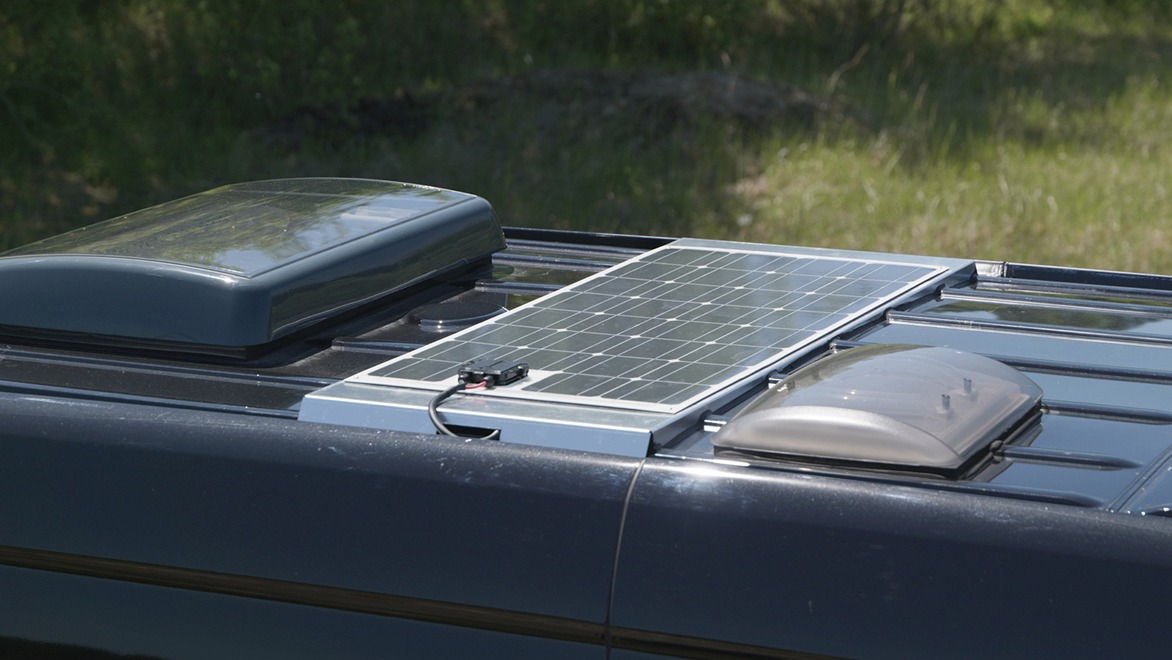
The sole purpose of having solar panels on a motorhome is to recharge its habitation battery. But not all solar panel systems are created equal. There can be significant differences in the way the panels have been mounted on the roof.
The components of a solar system, and the way they’ve been installed, will determine whether the solar panel system will fulfil your expectations while off-grid camping.
In this blog, we discuss what to look for when buying a used motorhome with solar panels. We touch on rigid and flexible solar panels, and the quality of the panels, solar controller, and habitation battery. We also chat about the electrical certificate of fitness, the wiring that connects everything together, and whether a portable solar panel may be your best solution.
How a solar panel system works
Solar panels convert sunlight into electricity. Also known as photovoltaic (PV) panels, they use the photovoltaic effect by exposing specific materials to light in order to generate an electric current. But how do they fit into a solar panel system?
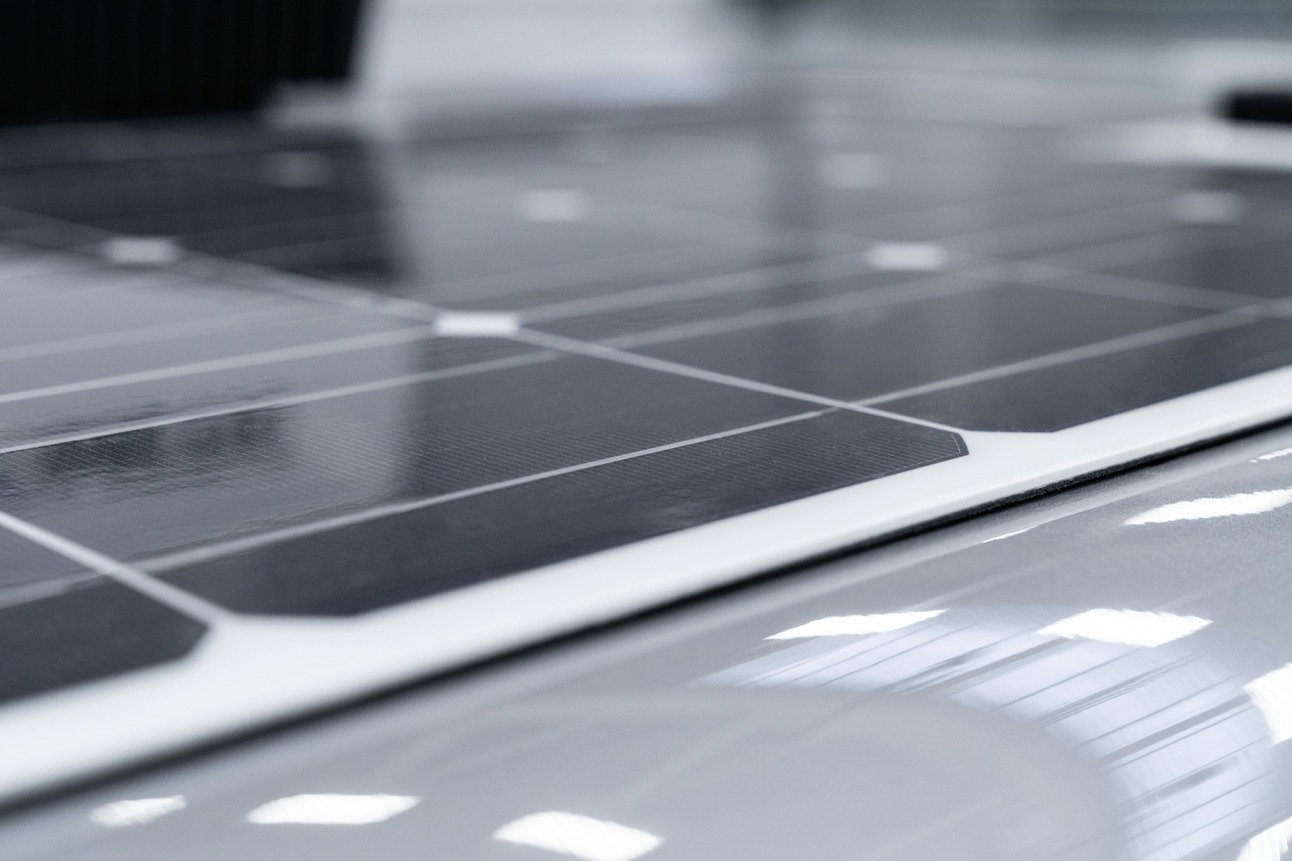
Solar panel systems in motorhomes usually have several components, including the:
- Solar panels — typically mounted on the roof to capture sunlight
- Solar charge controller — which regulates the voltage and current coming from your solar panels to protect the habitation battery from damage
- Habitation battery — stores the electricity that your solar panels generate
- Inverter — converts the direct current (DC) into alternating current (AC) so you can power the devices in your motorhome
- Wiring — your solar panels, charge controller, battery and inverter all need to be connected using appropriate wiring for energy efficiency and to prevent water ingress
- Mounts — framing, brackets and screws are required for securely mounting solar panels on a motorhome roof.
Circuit breakers and disconnection switches are also part of solar panel systems. These safety features help prevent damage and allow maintenance to be done.
Some systems may also have a battery monitor to help keep track of your energy storage and usage, plus a display panel with information on the system’s performance.
Do you really need solar panels?
Some motorhome enthusiasts are adamant that a fixed solar panel system is an essential accessory for your RV. However, it’s important to think about whether you actually need solar panels.
Your decision will likely depend on how you’re planning to travel and camp in your recreational vehicle. Do you intend to spend a lot of your time freedom camping and staying put in the same spot? If so, solar panels may greatly enhance the experience as you’ll be able to charge your habitation battery and therefore, stay away from civilisation for longer.
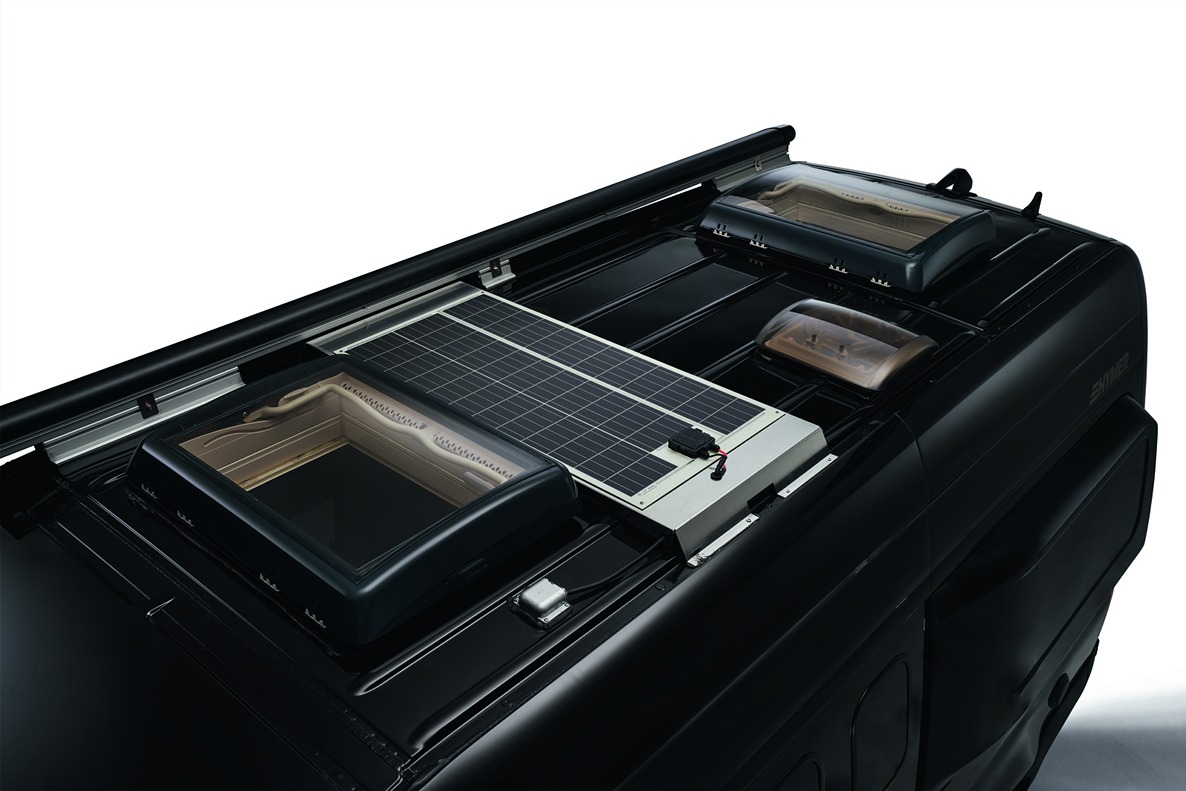
Alternatively, you may decide that you don’t need solar panels due to frequently recharging the habitation battery by:
- Staying at holiday parks or commercial campgrounds — where you can plug into mains power, or
- Changing campsites often — driving at least a few hours most days.
Check out our top ten essential motorhome accessories blog which includes solar panels.
Check the electrical warrant of fitness
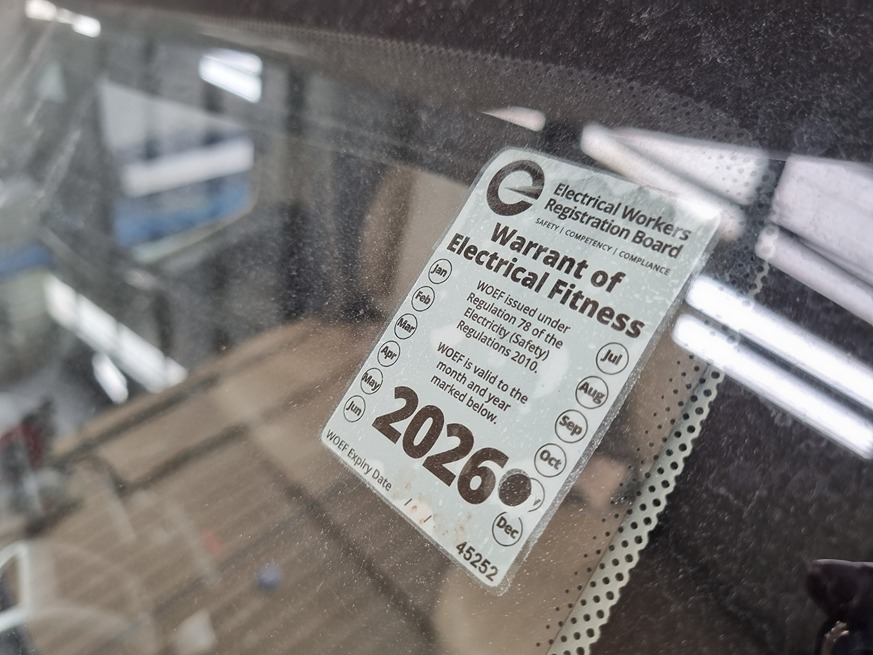
When assessing a used motorhome with a solar panel system, the first item to check is the motorhome’s warrant of electrical fitness (WoEF) so you can find out:
- How old the solar panel system is
- Whether the system was installed after the motorhome’s last electrical WoF test.
If the paperwork checks out, it will give you confidence to look closely at the different parts of the RV’s solar panel system.
|
Query the seller It’s prudent to ask the seller questions about their used motorhome’s solar panel system — like whether it was professionally installed and if you can take a closer look. |
For more things to consider, see our blogs on buying a used motorhome and the pros and cons of buying a premium ex-rental motorhome.
Choose the right solar panel mounts and frames
The two types of solar panels used on recreational vehicles are the:
- Rigidly-framed solar panels commonly found on motorhomes
- Flexible panels sometimes fitted to campervans.
The core of photovoltaic cells that capture energy from the sun is essentially shared by both types.
Rigid panels
Rigid panels are held in extruded aluminium frames so that they can be mounted horizontally above the roof. A gap promotes ventilation and keeps the temperature of each panel stable.
It’s important to know that to install this type of solar panel it needs to be attached to mounts that are secured on the motorhome’s roof. To secure the mounts, the roof needs to be drilled through several times. The mount bolts are sealed during the install to prevent leakage.
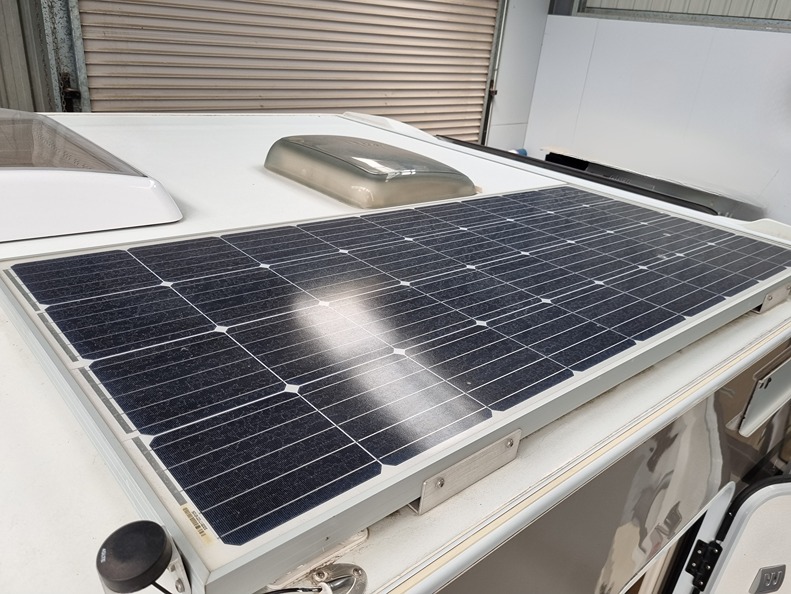
Check for any evidence of water leakage near the panel mounts inside the motorhome. Poorly installed panels could cause you major headaches which you’ll want to avoid.
If a motorhome was first sold from a dealer or manufacturer without solar panels, and has since had them installed, the water ingress warranty will be impacted. This is important to note as the area of installation won’t be covered anymore — due to this third party instalment.
Furthermore, any related issues also won’t be covered meaning the owner will have to cover these repair costs.
|
Always check mount bolt sealings lt’s worth your while making the effort to have a close look at the sealing of the mount bolts. You’ll want to be sure they’re in good condition and can continue to prevent water ingress. |
Flexible panels
Flexible panels are usually glued to campervans or motorhomes with either high roof extensions or pop-top roofs. They’re lighter than rigid panels as there’s no aluminium framing or mounting system to attach them to the roof.
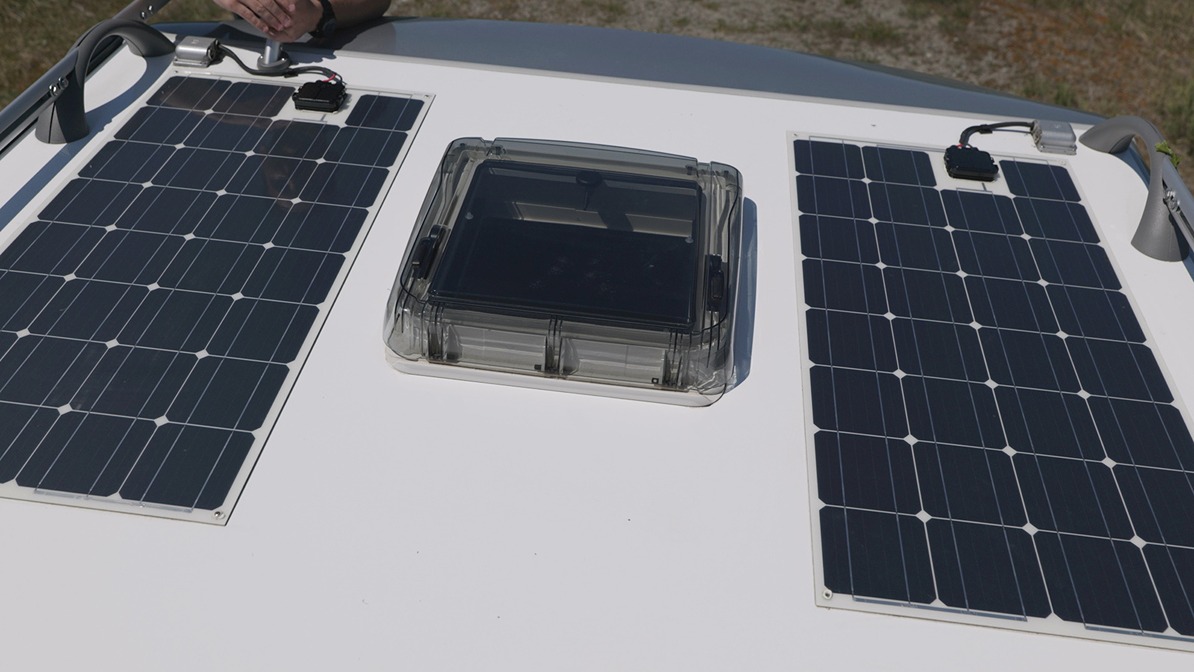
The panels can conform to moderate curves in your motorhome’s roof, enlarging the contact area between the adhesive and the panel. Some drilling may be required for the wires that transfer electricity from the panel to the habitation battery inside. Wherever there’s been drilling in a motorhome’s roof, be mindful of the potential for water ingress.
The sealing of these cable conduits should also be closely inspected if exposed.
|
Capturing solar energy — rigid versus flexible panels In strong sunlight, flexible panels typically don’t capture as much solar energy as rigid ones. This is because flexible panels are more susceptible to overheating — as there isn’t a gap between them and the roof of your motorhome. |
Gauge the quality of the solar panels
It’s probably a smoother ride for a solar panel system orbiting the earth while powering a satellite than it is for one riding atop a motorhome roof. When your solar-powered RV is on the move, there’s plenty of vibration — creating the potential for performance to degrade over time.
If installed properly on vibration-reducing rubberised mounts, a high-quality solar panel should last the 20 years that it usually does when sited on a house roof. When buying a second-hand RV with solar, it’s smart to find out how old the panels are — to estimate when they’ll need replacing.
Researching the manufacturer of the panels also offers an accurate guide to their quality. The longer the manufacturer’s warranty, the more capable your solar panels are of providing a long period of service. Expect there to be a two-year warranty term on installed solar panels — which should transfer to you as the new owner.
It’s unrealistic to expect a solar panel to achieve peak performance. Even in ideal conditions, a 100 watt (W) panel will only generate around 70W of electricity every hour.
|
Thicker is better A general rule of thumb when assessing the quality of a solar panel is that thicker is better. This means that the thin cellular core of the panel is protected by thicker glass. Therefore, the frame is likely to be better designed — to dampen vibrations before they reach the solar cells. |
Evaluate the quality of the solar charge controller
A solar charge controller (SCC) is used to charge your habitation battery by regulating the output from your array of solar panels. Its primary functions are to prevent the habitation battery from:
- Getting overheated and overcharged
- Discharging when your solar panels aren’t in use.
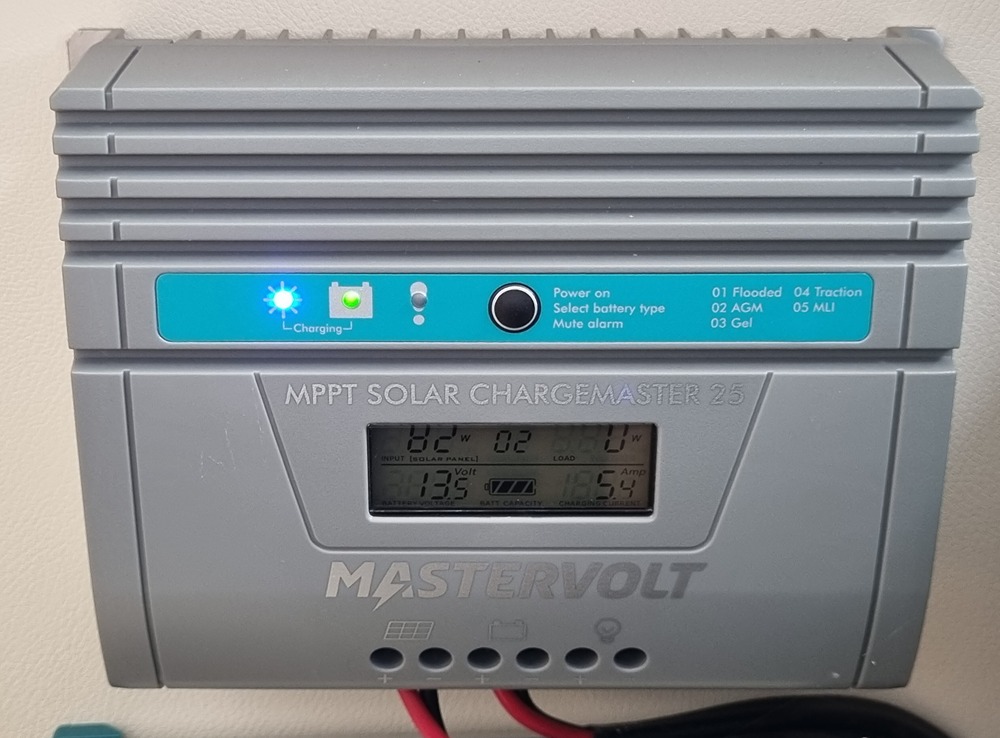
The controller has a proper heat sink built into it. This ensures that the charge from your solar panels to the habitation battery is constantly regulated over the entire life of the system.
Cheaper controllers dissipate heat using an electrical fan. However, the fans can fail at crucial times — resulting in damage to both the solar panels and the habitation battery.
The optimal position of your solar controller
It’s considered good practice to have the SCC mounted close to the habitation battery for:
- A reduced voltage drop — the distance the electrical current has to travel is minimised, lessening any drop in voltage between the solar panels and the battery
- Better system efficiency — a shorter wire run from the solar panels to the SCC to the habitation battery reduces energy loss
- More accurate temperature monitoring — which ultimately improves the charging process.
|
How to avoid overheating the habitation battery Your solar charge controller should always be mounted as close to your habitation battery array as possible. This makes the controller quicker to react should the voltage of the battery array suddenly drop due to overheating. |
Space or practical reasons may have prevented mounting the SCC right next to the battery. If this is the case, ask why the mounting location was chosen and whether high-quality wiring was used to help minimise energy loss.
Assess the quality of the habitation battery
Your solar panel system requires a habitation battery that can efficiently capture and discharge energy. Lead and lithium iron phosphate are the types of batteries to consider.
Lead batteries
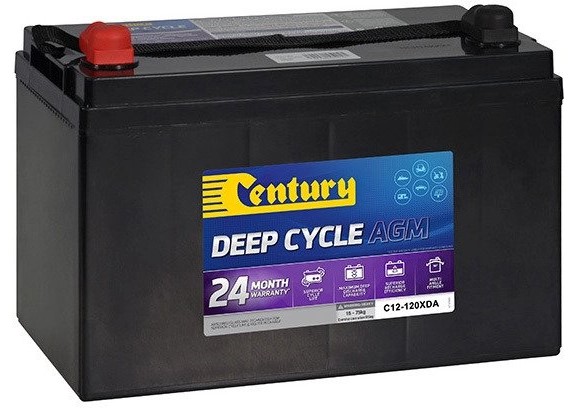
Lead batteries come in many forms. Some are designed to provide large amounts of current (amps) over short durations, such as those that will fire up a starter motor attached to the engine in a motorhome.
The battery chemistry in other models is formulated to provide less current over a long duration. Known as deep cycle batteries, they’re best suited to storing the electricity generated by solar panels.
Find out all you need to know about charging a motorhome battery.
|
Absorbent glass mat (AGM) lead batteries Make sure that the lead battery collecting energy from the solar panels is the deep cycle type — preferably with AGM internal architecture. AGM batteries are sealed and completely leak proof. This is important in a motorhome which vibrates while on the move. A leak proof design guarantees acid won't spill, protecting the battery and your motorhome — and you. |
Lithium iron phosphate batteries
Lithium iron phosphate (LFP) batteries are even better suited to deep cycle applications. This is because they:
- Can store more energy, and
- Are generally lighter and smaller in size.
An LFP battery may cost more than a similar deep cycle AGM battery upfront. However, it’s been proven to be more cost-effective over the long term — as it has a far longer life span. You can expect four times the number of charges and discharges from an LFP battery than its equivalent AGM before you have to discard it.
If you’re worried about the fire risk associated with lithium batteries, don’t. Only lithium-ion batteries pose a fire risk — such as those that power our mobile phones, laptops and some electric vehicles. LFP batteries have a totally different chemistry and are far more stable.
Learn about freedom camping for longer with lithium batteries.
|
Solar power and vehicle batteries don’t mix
|
Check for the right wire
Be sure that the cables feeding the solar power to your habitation battery are at least of 10-gauge outdoor specification. This is to prevent these cables from getting degraded by weather — and needing to be replaced before failing.
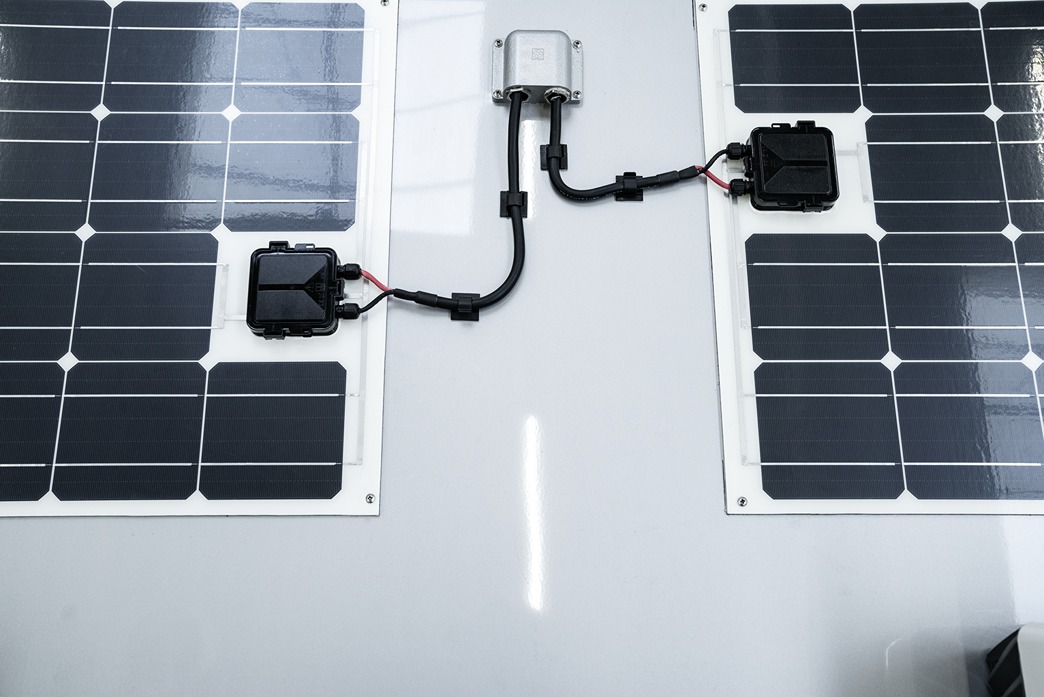
These cables lead from the panels through the roof into the motorhome so are susceptible to damage from sun, wind, rain and snow. The better the materials, the longer the equipment will last.
The lower the gauge number, the thicker the wire — so don’t worry if the cabling has a smaller number stamped on the outside.
Consider the portable solar panel solution
A fixed solar panel system isn’t the only solution for capturing energy when you’re off-the-grid. Also, look into whether a portable solar panel system can work for you.
New portable systems can capture just as much energy when you’re parked up. They offer a number of advantages, like:
- Maintaining aerodynamic efficiency — because the solar panel system components aren’t creating extra drag
- Lessening the chance of damaging the motorhome’s water-tight skin — by not requiring holes to be drilled in the roof
- Reducing deterioration from the weather — because they can be stowed away when not in use, even folding into their own special suitcase
- Minimising degradation from vibration while the motorhome is mobile — because they’re stored inside a storage compartment or the garage
- Freeing up roof space — enabling you to carry your kayak or surfboards on the roof.
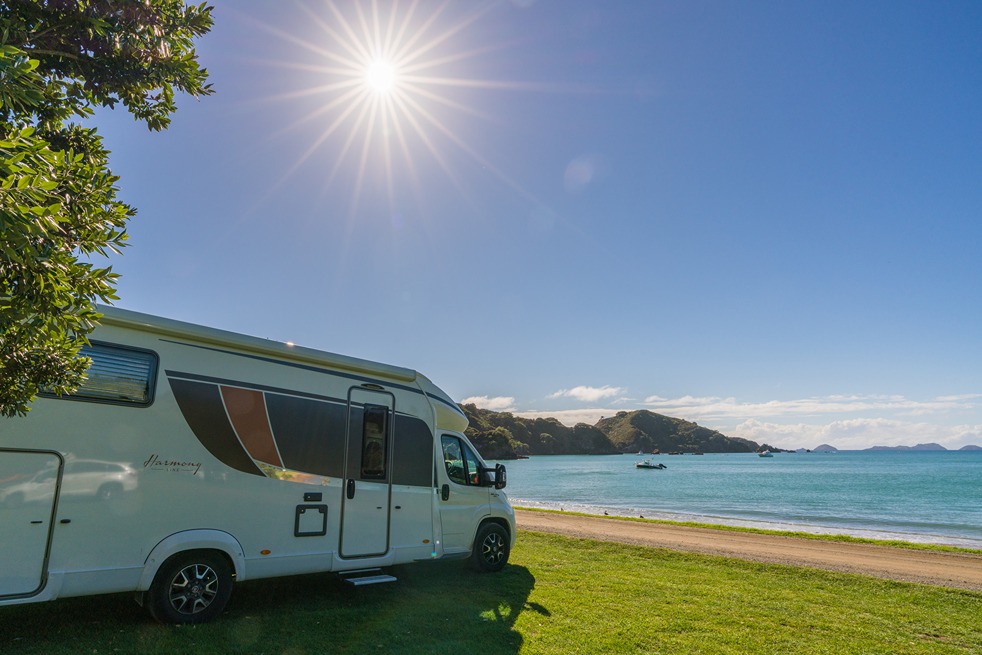
On scorchingly hot days, you can even park your motorhome in the shade while positioning the portable solar panels in the sun, connected by cable. Best of all with a portable system is that you can keep it when you sell your RV — ready to continue to be of service with your next motorhome.
Gather as much knowledge as you can on solar panel mounts and frames, the quality of the panels, habitation battery and solar controllers — plus, alternative portable solar solutions. When it comes to deciding between a motorhome with solar panels and one without, this information is vital for making an informed decision.
Solar panels are most useful when you’re off-the-beaten-track. Find the best off-road motorhome for your adventures.

